
delicious meat, poultry, and seafood dishes
This elegant recipe is a fabulous way to feature Southeast Asian herbs. It is a traditional dish and was given to me by Mai Truong, who grew up in Vietnam. It makes a great light first course or a special luncheon dish. Use leftover fish dipping sauce for a light salad dressing.
For the salad rolls:
1 lb (500 g) pork loin (or use leftover roasted or grilled pork loin)
16 to 20 medium raw shrimp
6 oz (200 g) fine rice vermicelli
1 large head leaf or butter lettuce
5 to 6 cups (250–300 g) loosely packed fresh herb leaves including: mint, Thai basil, perilla leaves, Vietnamese coriander (rau ram), and cilantro
2 cups (200 g) mung bean sprouts
1 twelve-oz (340-g) package of 11-in (28-cm) egg roll wrappers (made with wheat flour, tapioca, and water)
1 large bunch garlic chive leaves
1 tablespoon hot chili paste
For the hoisin dipping sauce:
½ cup (125 ml) hoisin sauce
2 tablespoons water
1 tablespoon unsalted, dry-roasted peanuts, finely chopped
For the fish dipping sauce:
3 to 6 garlic cloves, minced
3 fresh serrano peppers, seeded and minced
¼ cup (65 ml) fresh lemon juice
⅓ cup (85 ml) Vietnamese fish sauce (nuoc nam)
¼ cup (60 g) sugar
To make the salad rolls: In a saucepan, bring 1 quart (1 liter) of water to a boil. Add the pork loin; cover and simmer on low heat for about 20 to 30 minutes or until tender. Drain and cool the pork. In another saucepan, bring 2 cups (500 ml) of water to a boil, add the shrimp and simmer on low for about 3 minutes. Drain and set them aside. In a third pot, bring 1 quart (1 liter) of water to a boil, add the vermicelli and cook for 3 minutes. Drain, rinse in cold water, and set aside.
Before assembling the rolls, cut the pork into thin slices. Peel and devein the shrimp and slice each in half lengthwise. Wash and drain the lettuce and herbs. Place the pork, shrimp, vermicelli, lettuce leaves, herb leaves, and bean sprouts in bowls near a clean work surface.
Fill a large bowl with warm water and keep it at your work table. Dampen one egg roll wrapper at a time by dipping the edges into the warm water; place it on your work surface and dampen the middle by sprinkling it with water. Spread the moisture around with your fingers so the wrapper becomes evenly moist, but not wet. Let the wrapper soften a few seconds. (The thickness of the salad rolls can vary—it depends on how much filling you put in. After you fill and roll a few you will determine the final size you prefer.)
To fill the first wrapper, spread several strands of noodles on it, 2 inches (5 cm) from the bottom. Cover with part of a lettuce leaf, a selection of 3 or 4 different herb leaves, a small amount of bean sprouts, and three slices of the pork on top of each other. Fold the bottom part of the wrapper over the ingredients and fold in both sides of the wrapper, as you would to make a burrito. Place 3 shrimp halves and 3 whole garlic chive leaves on the top of the first roll of the wrapper, letting the chives stick out on one side. Finish rolling the wrapper up until it forms a cylinder. The shrimp will be visible from the outside through the wrapper. Repeat assembly for each roll.

To roll the salad rolls, first place the ingredients on the damp wrapper a few inches from the bottom.
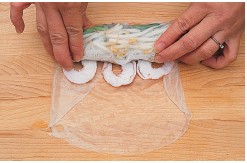
Fold the bottom part of the wrapper over the ingredients, then bring over the sides. Place 3 shrimp in front of the rolled part and roll a half turn.
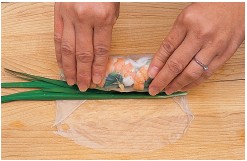
Place a few chive leaves on the wrapper

roll another turn until the roll is finished.
Place the finished rolls on a serving platter and garnish, or make up individual plates of 2 or 3 rolls each. Accompany the rolls with a small bowl of hoisin dipping sauce, another small bowl of fish dipping sauce, and a bowl of the hot chili paste. Makes 10 to 12 rolls, serves 4 to 6.
To make the hoisin sauce: Blend the hoisin sauce with the water. Put it in a small serving bowl and sprinkle with the chopped peanuts.
To make the fish dipping sauce: With a mortar and pestle, crush the garlic and peppers into a smooth paste. Put the lemon juice into a glass bowl, add the garlic-pepper paste, fish sauce, sugar, and ¾ cup (190 ml) warm water. Stir to combine. This dipping sauce can be kept in a jar in the refrigerator for several weeks. Makes 1½ cups (375 ml).
pork shoulder sandwiches with tomatillos
These sandwiches are variations on ones shown to me by Luis Torres and his sister Virginia Vasquez. Virginia’s brother-in-law, Javier Vasquez, who sold similar tortas from his food stand in Guadalajara, Mexico, was the original inspiration. The best way to describe these sandwiches is as sloppy joes with a south-of-the-border flavor.
For the meat filling:
5 lbs (2.5 kg) fresh pork shoulder
5 to 8 dried bay leaves (or 8 fresh bay leaves)
½ tablespoon whole cloves
1½ tablespoons vegetable oil
1 large white onion, chopped finely
4 cups (530 g) finely chopped tomatillos
2 large tomatoes, chopped finely
1 seven-oz (220-g) can chipotle en adobo (the amount you use depends on how much heat you want)
1 teaspoon cumin seeds
¼ teaspoon ground cloves
Salt to taste
To make the meat filling: Cut the pork off the bones into pieces approximately 2 x 3 inches (5 x 7.5 cm). Remove large pieces of fat but retain the bones. In a 12-quart (12-liter) kettle, put 2 quarts (2 liters) of water and bring to a boil. Tie the bay leaves and cloves in cheesecloth. Put the pork, the bones, and the cheesecloth bag into the boiling water. Simmer the pork for 2 hours, uncovered for the first hour, covered for the second hour, until it is very tender and shreds readily.
In the meantime, over medium heat, in a large frying pan, heat the oil; add the onions and sauté them for about 6 minutes or until they are translucent and just starting to brown. Add the tomatillos and sauté for about 5 minutes, then add the tomatoes and simmer for 10 minutes or until they are tender.
Heat a dry frying pan and toast the cumin seeds for a minute or so until they start to perfume the air. Grind the seeds in a spice grinder or mortar and pestle. In a blender, put the chipotle en adobo, the ground cumin, and the ground cloves. Add ½ cup (125 ml) of the pork cooking liquid and blend until smooth. Add the chipotle mixture to the tomatillo mixture and cook over medium heat, stirring, for about 5 minutes.
For the sandwich:
1 large white onion, thinly sliced
Juice of ½ lime
8 to 12 bolillo (Mexican rolls) or 6-in (15-cm) French sandwich rolls
8 tablespoons butter (1 stick)
6 medium tomatoes, sliced
1 head iceberg lettuce, thinly sliced
1 cup (230 g) Mexican crema or sour cream
When the pork is tender, drain it into a colander, saving the broth (you should have between 2 and 3 cups [500–750 ml] of broth). If you like your sandwiches especially sloppy, keep the 3 cups (750 ml); if you prefer them a little drier, boil the liquid down to 2 cups (500 ml).
Remove the bag of spices and the bones and discard them. Put the meat into a large bowl and cool. With your fingers, pull the meat into shreds; this can also be done with a potato masher. Return the reserved broth to the pot. Add the meat and the tomatillo mixture to the broth and bring it back to a simmer. Once hot, prepare the sandwiches or refrigerate and reheat to serve the next day.
To make the sandwich: Put the onion slices in a small bowl and marinate them in the lime juice for 20 minutes. Cut the rolls lengthwise until nearly halved. Liberally butter the rolls and toast them on a medium to hot comal or grill until they are quite brown. Make them into sandwiches with dollops of warm pork mixture, sliced onion, tomato, lettuce, and crema to taste. Add mariachi music and enjoy! Serves 8 to 10.

Georgeanne Brennan, author of Potager, contributed this recipe, which is called navarin printanier in French. She drew upon her years in France to create it.
2 lbs (1 kg) boned shoulder of lamb
Salt and freshly ground black pepper
2 tablespoons butter
1 tablespoon extra-virgin olive oil
2 tablespoons all-purpose flour
3 to 4 cups (750 ml–1 liter) beef stock, divided
2 garlic cloves
4 sprigs fresh parsley
4 sprigs fresh chervil (optional)
2 fresh bay leaves
16 very small new potatoes
16 small (2-in-/5-cm-long) new carrots
12 small new turnips
16 small onions, or 8 new shallots or 16 scallions (green onions)
2 cups (300 g) shelled peas (preferably petit pois)
Cut the lamb into ½-inch (13-mm) cubes. Toss with salt and pepper and set aside for an hour or so.
In a heavy casserole, melt the butter and add the olive oil. Brown the lamb over high heat; then remove it to a platter. Off heat, stir the flour into the pan juices in the casserole to make a thick paste. Return the casserole to the heat, and over high heat gradually add half the beef stock, stirring constantly. When the sauce is smooth, add the garlic, parsley, chervil, and bay leaves. Add the lamb, cover, and simmer for 1 hour.
Meanwhile, peel the potatoes, carrots, and turnips but leave them whole. Peel the onions (if you’re using scallions, peel them, trim the roots, and cut off the tops, leaving only the white plus 1 inch/2.5 cm of green). Add the potatoes, carrots, turnips, and onions to the casserole and cook for 45 minutes, uncovered. Skim any surface fat or foam. Add the peas and continue cooking until they are tender, about 5 minutes. Serve in a hot dish. Serves 4 to 6.
beef and pork japanese vegetable rolls
The Japanese have many elegant meat and vegetable combination dishes and this is one.
For the sauce:
¼ cup (65 ml) water
1 tablespoon sugar
1 tablespoon mirin
3 tablespoons soy sauce
For the rolls:
2 medium carrots (about 4 oz/125 g)
1 burdock root (about 4 oz/125 g) (optional)
1 tablespoon white vinegar
6 scallions (green onions)
4 oz (125 g) yard-long beans
1 teaspoon soy sauce
10 oz (390 g) lean beef or pork, teriyaki-style, and thinly sliced
2 tablespoons cornstarch
1 tablespoon vegetable oil
To make the sauce: Combine the water with the sugar, mirin, and soy sauce and set aside.
To make the rolls: Cut the carrots lengthwise into strips about 5 inches (13 cm) long and ¼ inch (6 mm) square. Peel the skin off the burdock root and cut it into the same size strips as the carrots. If using the bur-dock, to prevent discoloration soak it in water with the vinegar for 5 minutes. Cut the scallions and set them aside. Cut the yard-long beans into 5-inch (13-cm) lengths.
In a small saucepan, bring ¼ cup (65 ml) water to a boil, add 1 teaspoon soy sauce, the carrots, and the burdock root. Simmer the vegetables for 5 minutes, drain them, and set aside. Parboil the beans in 2 cups (500 ml) of water for 3 minutes, cool them quickly under running cold water, drain them, and set them aside.
Spread the beef or pork slices on a cutting board and sprinkle them lightly with cornstarch.
To assemble: Put 2 pieces of each vegetable and scallions on a piece of meat and roll them up tightly. Secure the rolls with a wooden toothpick. When all the rolls are done, sprinkle them lightly with cornstarch.
To serve: In a nonstick frying pan, heat the vegetable oil and brown the rolls evenly on all sides. You may have to do this in 2 batches. Return all the rolls to the pan and pour the sauce over the rolls and simmer them for another 5 minutes, turning them in the sauce so they are evenly glazed. Serve on individual plates while still warm. Serves 4.

This is a classic Mexican recipe. Prickly pear cactus paddles or chard can be used instead of the purslane and pork short ribs for the pork loin. Serve the stew with corn tortillas and, for garnishing, fresh salsa, chopped cilantro, and Mexican crema, if you choose. Leftover stew is great the next day served with warm tortillas.
For the sauce base:
1 lb (500 g) tomatillos, husked
2 to 4 serrano peppers
1 small white onion, quartered
2 cloves garlic, unpeeled
½ cup (250 ml) beef broth
½ cup (25 g) cilantro, chopped
Salt to taste
For the stew:
2 tablespoons vegetable oil
1½ lbs (725 g) pork loin, cubed
1 medium white onion, finely chopped
1 clove garlic, minced
6 Yukon gold or red boiling potatoes, peeled and quartered
3 cups (130 g) purslane shoots, thick stems removed (usually grows in cultivated fields, and is more likely found at a farm stand or Mexican market than at the supermarket)
1 teaspoon dried Mexican oregano
Salt to taste
Garnish: chopped cilantro
To make the sauce base: On a hot comal or cast-iron frying pan, toast the tomatillos, serranos, onions, and garlic until brown. Remove the seeds from the serranos and the skin from the garlic. In a blender, purée the toasted vegetables with the beef broth until smooth. Add the chopped cilantro and salt, stir, and set aside.
To make the stew: Preheat the oven to 325°F (160°C). In a heavy-bottomed ovenproof pot with a cover, or a Dutch oven, heat the oil. Add the pork and brown over medium heat, about 15 to 20 minutes. (You probably need to do this in at least 2 batches.) Remove the meat from the pot and set aside. Sauté the onions and garlic in the same pot over low heat until tender. Add the tomatillo sauce base and bring it to a rolling boil; add the meat, cover the pot, and bake in the oven for 30 minutes. Add the potatoes, cover, and bake for 20–30 more minutes or until the potatoes are tender. Add the purslane and cook 5 minutes more. On a hot comal or dry frying pan, toast the Mexican oregano for about 30 seconds; cool and crumble. Season the stew with the oregano and salt. Serve with the chopped cilantro. Serves 4.
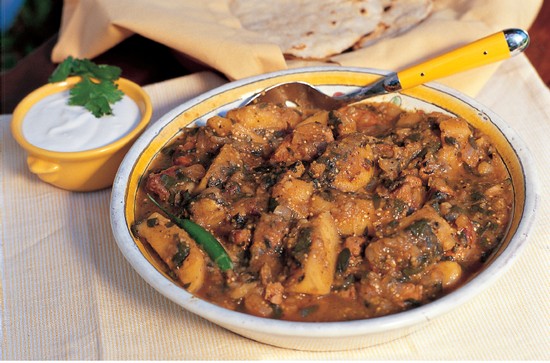
Making this chili, full of lively fresh flavors and colors, is a festive way to celebrate the late-summer harvest. Be creative and flexible and use the vegetables and herbs your garden offers. For a vegetarian version, omit the meat and double the quantity of beans and garlic. Serve with corn bread and a green salad.
½ lb (250 g) dry beans (recommended: pinto, kidney, or red Mexican; about 1¼ cups) or 2 to 3 cups (380–580 g) fresh shelled beans (omit precooking)
¼ cup (65 ml) extra-virgin olive oil
2 onions, chopped
1 lb (500 g) chuck roast or steak, cut into ½-in (2.5-cm) cubes
4 garlic cloves, minced
1 or 2 chili peppers, minced
3 tablespoons chili powder
2 teaspoons cumin
2 quarts (1.5 kg) tomatoes, peeled and seeded (about 8 medium tomatoes)
1 or 2 sweet peppers, diced
2 small or 1 large summer squash (recommended: 1 each yellow and green zucchini), diced
¾ cup (130 g) fresh corn kernels (cut from 1 ear)
1½ tablespoons minced fresh oregano
¼ cup (10 g) minced fresh basil or parsley
Cover the dry beans generously with water and soak overnight. Before cooking, add more water if needed to cover beans and simmer 1½ to 2 ½ hours or until just tender.
In a large kettle, sauté the onions in olive oil until soft. Add the meat, garlic, chili peppers, chili powder, and cumin, and sauté about 4 minutes.
Add the tomatoes, cover the kettle, and simmer about 1 hour, stirring occasionally. Add the remaining vegetables, the herbs, and the cooked dry beans (or fresh shelled beans, if used) and simmer ½ hour longer. Serves 8 to 10.
black bean and chicken chili
This recipe was contributed by Jesse Cool, owner and chef at Flea Street Café in Menlo Park, California. You’ll be amazed at all the rich flavors.
2 cups (400 g) dry black beans
2 lbs (1 kg) meaty chicken (breasts and/or thighs)
Salt and pepper
¼ cup (65 ml) olive oil
1 large onion, chopped
½ cup (50 g) chopped celery
¼ cup (35 g) minced garlic
1 to 2 fresh hot peppers, seeded and minced
3 tablespoons chili powder
2 tablespoons cumin
3 tablespoons butter
½ cup (75 g) currants or raisins
½ cup (75 g) chopped carrots
1½ oz (45 g) bittersweet chocolate
Pinch of cinnamon
Cover the beans generously with water and soak overnight. Add more water if necessary. Bring to a boil and simmer until tender but not mushy, about 2 hours.
Put the chicken in a pot with 3 cups (750 ml) of water and the salt and pepper. Cover and simmer until the chicken is done, about 30 minutes. Remove the chicken from the broth and reserve the broth. Debone and skin the chicken and cut it into bite-size pieces.
Sauté the onion, celery, garlic, and hot pepper in the olive oil until tender. Add the chili powder, cumin, and butter, and sauté for 1 more minute.
Add the currants or raisins, carrots, 2 cups (500 ml) of the reserved chicken broth, chocolate, and cinnamon, along with the beans (drained of any excess cooking liquid). Add more broth if necessary. Let mixture cook, covered, on low heat about 45 minutes. Add the chicken, taste for seasoning, and simmer about 30 minutes longer. Serves 8.
Gumbo (an African word for okra) starts with a dark roux and is often thickened with okra and/or filé powder, made from the dried leaves of the sassafras tree. Serve with white rice.
For the roux:
½ cup (125 ml) canola oil
¾ cup (115 g) flour
1 quart (1 liter) chicken stock
For the gumbo:
2 lbs (1 kg) beef brisket (fat trimmed off) or 1 frying chicken, cut in large pieces
¼ cup (65 ml) canola oil
1 lb (500 g) fresh okra, finely sliced
2 large onions, chopped
1 bell pepper, chopped
1 cup (120 g) chopped celery
3 garlic cloves, minced
2 fresh hot peppers, seeded and minced
2 cups (400 g) peeled, seeded, and chopped tomatoes
2 bay leaves
1 tablespoon minced fresh thyme (or 1 teaspoon dried thyme)
1 to 2 lbs (500 g–1 kg) U.S. farmed or wild caught raw shrimp, shelled and deveined
About 2 lbs (1 kg) assorted seafood such as crab, fish, lobster, and crayfish (optional)
2 tablespoons filé powder
Salt and freshly ground pepper to taste
To make the roux: In a large heavy pot, combine the oil with the flour. Stirring constantly with a whisk or wooden spoon, cook over medium-high heat until the mixture turns a reddish brown, about 15 minutes. Bring the stock to a boil and add it slowly to the roux while constantly stirring. The mixture should thicken and become smooth.
To make the gumbo: In a large frying pan, brown the meat in the oil. Remove the meat and pour out and reserve the oil. Add 2 cups (500 ml) of water to the pan drippings and boil to dissolve. Scrape the drippings from the bottom of the pan and pour into a separate bowl.
Put the reserved oil back in the pan and add the okra, onions, bell pepper, celery, garlic, hot peppers, tomatoes, bay leaves, and thyme. Cook over low heat for about ½ hour until they are soft and slightly brown, then remove the vegetables from the pan and set aside. Return the meat to the pan, add the reserved drippings, cover, and simmer on low heat for 45 minutes or until tender.
To assemble the gumbo: Combine the roux mixture, the vegetables, and the stewed meat in one pot. Bring to a boil, add the shrimp and other seafood (if using), and cook about 5 minutes. Stir in the filé powder and let the gumbo rest 5 minutes to allow the filé to thicken before serving. Add salt and freshly ground pepper to taste. Serves 6.
beerocks (stuffed bread pockets)
Many of our “heirloom” recipes came from English kitchens, but our early American heritage draws from other nationalities as well. This old family recipe from Jan Blüm’s Grandma Bender originated in Germany. These days, Jan, owner of Seeds Blüm, uses a vegetarian filling instead of meat. As you may notice, beerocks are very similar to Russian piroshkis. Mustard is a good accompaniment.
For the dough:
2 cups (500 ml) whole milk
½ cup (215 g) sugar
½ cup (125 ml) vegetable oil
1 teaspoon salt
2 packages (14 g) dried yeast
6 cups (660 g) all-purpose flour
For the filling:
¼ cup (65 ml) vegetable oil
1 lb (500 g) ground beef
2 large onions, chopped
1 large head cabbage, loosely shredded
A few leaves of kale or other leafy green (optional)
Salt and freshly ground black pepper
To make the dough: In a saucepan combine the milk, sugar, vegetable oil, and salt. Heat the mixture until the sugar has dissolved, but do not allow it to boil. Cool the mixture to lukewarm. Pour the milk mixture into the bowl of a heavy-duty mixer with a dough hook and stir the yeast into it. Add the flour 1 cup (110 g) at a time and knead with the dough hook until it forms a ball. Turn the dough over in an oiled bowl, cover with plastic wrap, and let it rise in a warm place such as a 200°F (95°C) oven until it doubles in size, about 2 hours. Punch the dough down and let it rise for another hour. While the dough is rising the second time, prepare the filling.
To make the filling: In a large frying pan, heat the oil and brown the meat and onions over medium heat. Add the cabbage (and other greens if desired) and salt and pepper to taste. Cover and cook until crisp-tender. The frying pan will be full at first, but the cabbage will shrink during cooking. Do not over-cook. Take off the cover as soon as the cabbage has wilted, or the mixture will become too “juicy.”
Preheat the oven to 450°F (230°C) and grease a cookie sheet with some oil.
After the dough has risen, place it on a floured board. Roll it out as thin as possible into a rectangle. Cut it into 8-inch (20-cm) squares. Spoon 2 to 3 tablespoons of the filling into the center of each square, being careful not to get any oil on the dough edges. Join the four corners of each square in the center and pinch each seam closed to make an envelope. Place the beerocks on the oiled cookie sheet, then turn them seam side down to oil both sides. Bake them for about 15 to 20 minutes, until they are nicely browned. Serve immediately. Serves 16 as a side dish, 8 as a main course.
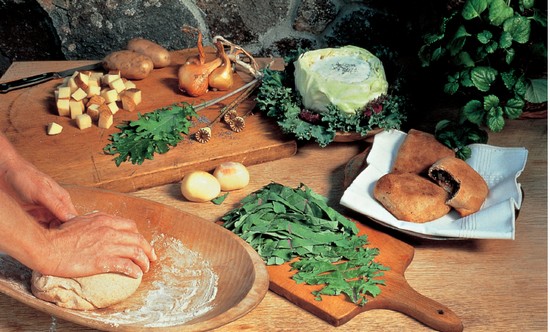
A traditional recipe with a long history, baked beans are an American classic. In early America baked beans were not a vegetable dish but a pork dish; the beans were used to stretch the meat portion of the meal. The bean dish with molasses and salt pork we know today was first reported in 1840. This recipe is based on one from The American Frugal Housewife, by Lydia Marie Child.
1 lb (500 g) red kidney or heirloom dry beans
1 tablespoon vegetable oil, or ¼ lb (125 g) salt pork, cut into 1-in (2.5-cm) cubes
1 lb (500 g) lean pork, fresh pork shoulder, or boneless pork chops, cut into 1-in- (2.5-cm-) wide strips
1 medium onion, chopped
⅓ teaspoon dried thyme
Freshly ground black pepper
¼ teaspoon salt
Pick over the beans, removing any debris, and wash them. Place them in a large saucepan and cover them with 2 inches (5 cm) of water. Either let them sit overnight or bring them to a boil for 1 minute, then remove from the heat and let them sit for 1 hour.
Cook the beans for 1 to 1½ hours until they are just tender. Drain them, setting the bean liquid aside.
In a large frying pan heat the oil (if using salt pork, sauté it for 2 or 3 minutes) and over fairly high heat brown half of the pork on all sides. Transfer it to a bean pot or a 3-quart (3-liter) covered Dutch oven. Repeat the process with the rest of the pork. Pour off the remaining grease. Carefully deglaze the pan with a little of the bean water and pour it over the pork. Add the beans, onion, thyme, pepper, and salt (omit the salt if you are using salt pork). Mix the ingredients and add enough bean liquid to just cover the beans. If you don’t have enough liquid, add a little stock or boiling water. Cover the bean pot.
Bake at 300°F (150°C) for 4 to 6 hours. Check occasionally to make sure the liquid still covers the beans. If it gets too low, add more bean liquid or boiling water. Half an hour before the beans are done, uncover and let the beans brown slightly on top. Serves 6 to 8.
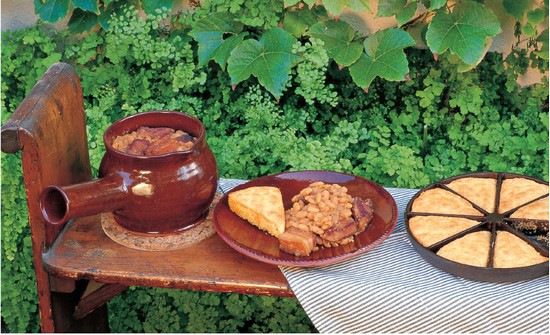
bitter melon with beef stir-fry
Bitter flavors are an acquired taste, but if you enjoy bitter beer and radicchio you’ll probably delight in this rich and complex dish. Serve it with steamed rice.
1 tablespoon dry sherry
1 tablespoon soy sauce
1 tablespoon cornstarch
½ lb (250 g) beef tenderloin, cut in thin strips across the grain
1 lb (500 g) bitter melon
½ teaspoon salt
1 red bell pepper
2 tablespoons peanut oil, divided
2 garlic cloves, minced
1 tablespoon grated fresh ginger root
2 tablespoons black bean sauce
2 teaspoons sugar
Garnish: 2 tablespoons of chopped fresh cilantro
Combine sherry, soy sauce, and cornstarch in a small bowl. Add the beef strips, coat thoroughly and set aside. Cut the bitter melon lengthwise; remove inside pulp and seeds. Slice thinly. Put into a bowl and sprinkle with salt. Let the melon sit for 20 minutes to remove some of the bitterness. After 20 minutes, squeeze out the water. Cut the red pepper in thin slices.
In a hot wok, heat 1 tablespoon of the oil. Add the bitter melon, garlic, and ginger and stir-fry for about 3 minutes. Remove the vegetables and put them on a warm serving plate. Add the remaining tablespoon of oil to the wok, heat and then add the beef strips. Stir over high heat until the meat starts to brown but is still pink inside. Add the marinating juices, bean sauce, 1 cup (250 ml) water, and the sugar. Cook for 1 more minute, but do not overcook. Arrange the beef strips over the vegetables on the platter. Garnish with chopped cilantro. Serves 4.
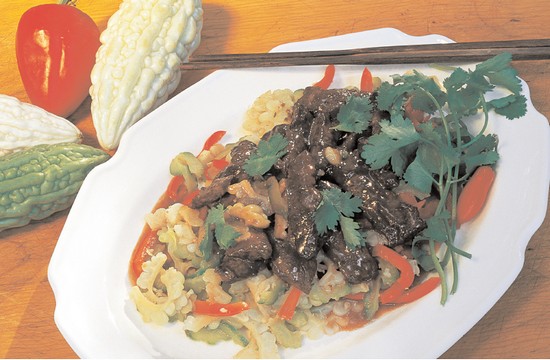
Pea shoots are a special vegetable and greatly enjoyed in China. Here is an elegant pairing with crab. Serve this dish with steamed rice.
For the sauce:
2 garlic cloves, minced
1 tablespoon vegetable oil
1 tablespoon cornstarch
1 cup (250 ml) chicken stock
2 tablespoons sherry
½ lb (250 g) cooked Alaska king crab meat (about 1 cup)
4 tablespoons chopped, blanched Chinese leek leaves or 1 tablespoon chopped fresh Oriental chive leaves
Salt
For the pea shoots:
1 tablespoon sesame oil
1 quart (170 g) coarsely chopped fresh pea shoots
To make the sauce: In a saucepan over low heat, sauté the garlic in the vegetable oil until tender, about 1 minute. In a small bowl, blend the cornstarch with the chicken stock and sherry. Add the mixture to the pan and heat, stirring constantly until the sauce is thickened. Add the crabmeat and the Chinese leeks and simmer for another minute. Remove from the heat, and add salt to taste.
To make the pea shoots: In a wok or large pan, heat the sesame oil and stir-fry the pea shoots for about 3 minutes or until just tender. Lightly toss them with the sauce. Serves 4.
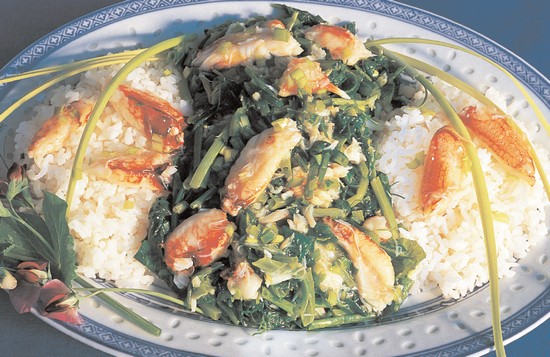
shishito pepper and eggplant stir-fry with beef
I learned about cooking baby Japanese eggplants and using mioga ginger blossoms from a woman selling both at the local farmers’ market. Serve this dish with a vegetable stir-fry and rice cooked with soybeans (see the recipe on page 150) for a complete meal.
For the marinade:
1 tablespoon dry sherry
2 tablespoons soy sauce
1 tablespoon cornstarch
½ teaspoon sugar
½ lb (250 g) beef filet strips
For the stir-fry:
2 tablespoons peanut oil
8 to 10 oz (250–300 g) Japanese baby eggplants, or larger eggplants cut into small strips
1 medium onion, chopped
16 green Shishito peppers or 1 sweet green Italian frying pepper cut into small strips
16 red Shishito peppers or 1 sweet red Italian frying pepper cut into small strips
6 mioga ginger blossoms, quartered (optional)
2 garlic cloves, minced
2 tablespoons fresh cilantro, chopped
2 teaspoons grated fresh ginger root
2 tablespoons oyster sauce
½ to ¾ cups (125–190 ml) chicken broth
½ teaspoon hot red pepper flakes
To make the marinade: In a small bowl, combine the sherry, soy sauce, cornstarch, and the sugar. Stir until the cornstarch is completely dissolved. Add the beef strips, toss, and set aside.
To make the stir-fry: Over high heat in a nonstick wok, heat the peanut oil until it is very hot. Add the eggplants and stir-fry over high heat for 3 minutes. Add the onion, green and red peppers, and ginger blossoms; stir-fry 2 more minutes. Toss in the minced garlic, cilantro, and grated ginger; cook for a couple of seconds. Put on a plate and set aside.
Heat the wok again, adding a little more peanut oil if necessary, and stir-fry the marinated beef for 1 minute or until medium rare. Return the vegetables to the wok, and then stir in the oyster sauce, the chicken broth, and the red pepper flakes. Heat together for another minute, and then serve the stir-fry at once over rice. Serves 4.
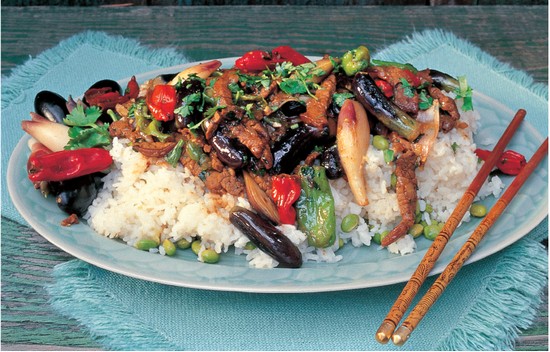
grilled swordfish with rosemary
This recipe is from Carole Saville, author and herb maven. It blends the richness of swordfish with the assertiveness of rosemary. It works equally well when broiling the swordfish instead. Note that the swordfish needs to marinate for an hour. Many types of swordfish are threatened by overfishing. Look for domestic American swordfish, as it comes from well-managed sources.
¼ cup (10 g) fresh rosemary leaves and soft stems
1 cup (250 ml) olive oil
2 tablespoons lemon juice
¼ teaspoon salt
Cayenne pepper
4 yellowfin swordfish steaks, 1 in (2.5 cm) thick (about 5 oz/150 g each)
Garnish: 4 teaspoons finely chopped fresh rosemary, rosemary flowers (if in bloom), and lemon wedges
Finely chop the rosemary. Put it in a small bowl and with the bottom of a drinking glass rub the rosemary to bruise it. In a large, deep plate, combine the olive oil, lemon juice, salt, cayenne pepper, and rosemary, stirring to combine. Rinse the swordfish and pat it dry. Turn each steak over in the marinade to coat it well. Cover and refrigerate the swordfish for 1 hour, turning it once after 30 minutes.
Grill the swordfish over a medium flame, turning it after 5 minutes. Continue to grill until the flesh is opaque when cut in the thickest part, about 5 more minutes. Remove the steaks and place on four warmed plates. Sprinkle 1 teaspoon of chopped rosemary over each serving. Further garnish with rosemary flowers and lemon wedges. Serve immediately. Serves 4.
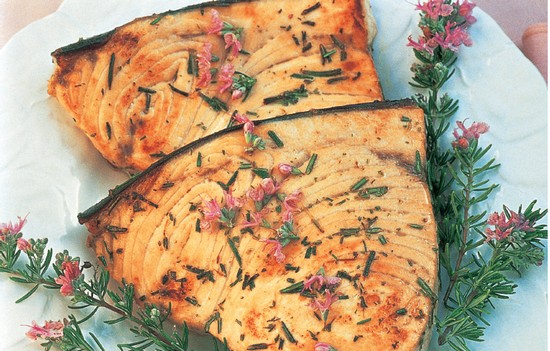
David Cunningham, one-time staff horticulturist at the Vermont Bean Seed Company, created this recipe to take advantage of his many Asian greens. When possible look for trap-caught, U.S. farmed, or trawl-caught shrimp. Serve this stir-fry with steamed rice.
For the shrimp marinade:
1 tablespoon tomato paste
1 tablespoon cornstarch
1 tablespoon soy sauce
2 tablespoons vinegar
2 tablespoons water
½ teaspoon Chinese mustard
1½ lbs (725 g) raw shrimp, shelled, cleaned, and deveined
For the sauce:
½ cup (125 ml) chicken stock
1 tablespoon cornstarch
1 tablespoon soy sauce
2 teaspoons honey
4 large garlic cloves, minced
For the stir-fry:
¼ cup (65 ml) peanut oil, divided
2 large heads pac choi, stems sliced diagonally in 2-in (5-cm) pieces
4 scallions (green onions), sliced diagonally
1 quart (280 g) tatsoi leaves
To make the marinade: Mix the marinade ingredients together, add the shrimp, and refrigerate for 3 hours. Drain and reserve both the liquid and the shrimp.
To make the sauce: Mix the sauce ingredients together, add the drained marinade liquid and set aside.
To make the stir-fry: Heat the wok over high heat and add about half the oil. Stir-fry the shrimp quickly in small batches. As they are cooked, put the shrimp and any juices into a bowl and reserve.
Add the remaining oil and stir-fry the pac choi stems and scallions for about 1 minute. Add the tatsoi leaves and stir until they are wilted. Add the sauce, lower the heat, and stir until thickened. Add the cooked shrimp together with their liquid. Heat all together while stirring, for 1 more minute. Serves 6 to 8.
steamed rice
Steamed white rice is basic to all of Asia. In China and Japan they use short-grain rice. In India, however, they commonly use a long-grain, or fragrant basmati rice. The following recipe is the most basic and applicable to most white rice varieties. If you use a rice cooker, follow the proportions and directions that come with it. An interesting variation, and one packed with nutrition, is to make the rice with fresh green soybeans. The beans will cook in the same amount of time as the rice.
1½ cups (340 g) uncooked white rice
2 cups (800 ml) water
Optional: 1 cup (200 g) shelled green soybeans
Rinse the rice under running water, then drain and place in a pot with a tight-fitting lid. (If using, add the optional green soybeans to the rice at this point.) Cover and bring to a boil. Reduce the heat to low and simmer for 15 minutes. Turn off the heat (don’t lift the lid!) and let it sit covered for another 15 minutes. Fluff lightly and then serve. Serves 4.
golden chicken curry with garam masala
I learned to make “real” curry from my friend Bhadra Fancy, who grew up outside Bombay. What a difference! Instead of a generic mix of spices in a tin, you grind your own fresh aromatic spices, including your own hot peppers. Called garam masala in India, the spices in curry vary from region to region, cook to cook, and from season to season.
A vegetarian version is quite wonderful as well. Here, instead of chicken, whole baby eggplants, potatoes, a whole cauliflower cut in florets, and snap beans are simmered with the garam masala. These curries are served over rice with raita (a yogurt and mint sauce) and flat breads.
For the masala paste:
1 tablespoon whole coriander seeds
1 tablespoon whole cumin seeds
½ teaspoon cardamom seeds (the seeds from about 6 pods)
10 black peppercorns
1 teaspoon ground cinnamon
¼ teaspoon ground cloves
2 teaspoons ground turmeric
1 teaspoon ground cayenne pepper
2 teaspoons salt
2 tablespoons poppy seeds
12 whole blanched almonds
5 tablespoons unsweetened coconut milk
1 cup (100 g) chopped onions
8 garlic cloves
½-in (3-mm) piece fresh ginger, peeled and sliced
1 or 2 yellow or red fresh jalapeño peppers, seeded
1 yellow or red fresh cayenne pepper, seeded
For the curry:
2 tablespoons vegetable oil
1 (3-lb/1.5-kg) chicken, skin removed, cut into serving pieces
1 onion, chopped
2 yellow bell peppers, cut in ½-in (13-mm) pieces
8 Italian paste tomatoes, peeled, seeded, and chopped
2 cups (300 g) whole baby carrots, or large carrots cut in thick coins
8 small potatoes, peeled
1 tablespoon lemon juice
To make the masala paste: In a dry frying pan, toast the coriander, cumin, and cardamom seeds over medium heat until they just begin to perfume the air. Cool and then combine the toasted seeds and the peppercorns and grind them into a powder using a spice grinder or a mortar and pestle. In a food processor or blender, blend the toasted ground spices and the remaining ingredients into a smooth paste. Set the masala paste aside.
To make the curry: In a Dutch oven, heat the vegetable oil. Add the chicken pieces and brown them over medium heat for about 20 minutes or until they are a rich golden brown. Remove the chicken from the pan.
Add the onion and bell peppers to the same pan and sauté over medium heat until they are soft, about 5 minutes. Add the chopped tomatoes, the reserved masala paste, and 4 cups (1 liter) of water. Stir and bring the mixture to a simmer. Return the chicken pieces to the pan, add the carrots and potatoes, and simmer covered for about 30 minutes. Stir in the lemon juice. Serve the curry with rice. Serves 6.

A boiled dinner has long been a favorite coldwinter-night dish. A particular favorite in colonial America, it could have been boiled up over the fire a good part of the day, needing little attention. Further, leftovers could be cooked up in hash the next day. Avoid the plastic-wrapped brisket from the supermarket, as it is tough and fatty. Get a lean one from a butcher. Serve with mustard, horseradish, and/or pickles.
3 to 4 lbs (1.5–2 kg) extra-lean corned beef brisket
2 tablespoons pickling spice in a cheesecloth bag, or 6 whole cloves, 4 whole allspice, ½ teaspoon peppercorns, 1 tablespoon mustard seeds, and 2 bay leaves in cheesecloth bag
5 or 6 medium potatoes, quartered
5 or 6 medium carrots, cut into chunks
2 large onions, thickly sliced
4 turnips and/or 4 golden beets, peeled and quartered (optional)
1 medium head cabbage, cut into 6 or 8 wedges
For the glaze:
⅓ cup (85 ml) Dijon mustard
¼ teaspoon ground cloves
2 tablespoons brown sugar
In a large kettle or Dutch oven, cover the meat with water. Boil for half an hour; pour off the water and discard it. Add fresh boiling water to cover the meat, add spices, and simmer for 45 minutes per pound of meat (minus the first half hour), or until fork-tender. Remove the meat to an ovenproof pan, fat-side up. Add the potatoes, carrots, and onions (and turnips and beets, if desired) to the kettle, cover, and boil for 15 minutes. Place the cabbage on top of the other vegetables and cook 10 more minutes, or until tender. Preheat the oven to 350°F (175°C).
Meanwhile, glaze the beef. Paint the mustard on the beef, sprinkle with cloves, then with the brown sugar. Bake for 15 to 20 minutes. Place the meat on a large serving platter and surround it with the vegetables. (Discard cooking water and spices.) Cut the meat across the grain. Serves 6 to 8.
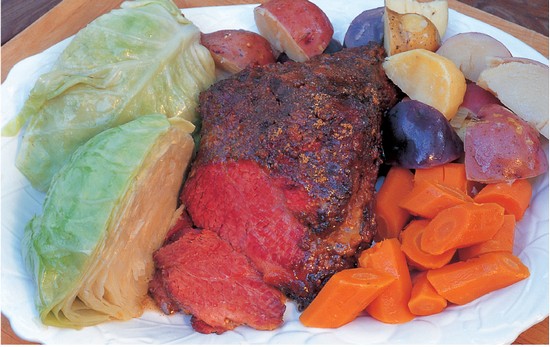
pickled mustard cabbage stir-fry with pork
Mai Truong, who grew up in Vietnam, shared with me her favorite dish using pickled mustard—in this case with pork. I’ve also enjoyed adding shredded bamboo shoots, pea pods, and carrots to this recipe. Serve this dish with rice and soy sauce. For a complete meal accompany it with another stir-fry and a light soup. If you can’t make your own, pickled mustard is available in the refrigerated section of most Asian markets.
½ lb (250 g) lean pork, cut in thin strips across the grain
⅛ teaspoon salt
6 garlic cloves, minced, divided
1 lb (500 g) pickled mustard cabbage (see recipe on page 31)
2 tablespoons vegetable oil
Fresh cilantro leaves, chopped
Fresh scallions (green onions), chopped
Sprinkle the pork strips with the salt and half the minced garlic. Marinate the mixture for about 1 hour. Drain the pickled mustard and chop it into 1-inch (2.5-cm) pieces. In a hot wok heat the oil. Sauté the remaining garlic until it is starting to turn golden. Add the pork strips and stir-fry until the meat turns gray. Add the pickled mustard and ½ cup (125 ml) of water. Cook for 3 more minutes, transfer to a warm platter and garnish the dish with cilantro and scallions. Serves 4.

babyback ribs with ancho chilies
All types of flavorings, including ground dried cayenne, paprika-types, and mirasol/guajillo chilies as well as ancho chilies, can be used in a dry rub to flavor ribs. Other traditional flavorings include ground oregano and cumin, brown sugar, dry mustard, and garlic. You can create your own formula using your favorite dried hot pepper or try the one given here.
Accompany the ribs with your favorite barbecue sauce, mashed potatoes, and coleslaw or a salad.
4 tablespoons ground dried ancho chilies
2 teaspoons salt
¼ teaspoon ground cumin
1 teaspoon brown sugar
4 to 6 lbs (2–3 kg) babyback (loin) pork ribs
Blend the ground chilies, salt, cumin, and sugar in a small bowl. Rub the ribs with the mixture, thoroughly covering both sides. Cover the ribs tightly with plastic wrap and refrigerate for 6 to 8 hours or overnight.
Preheat the oven to 300°F (150°C). Wrap the ribs in aluminum foil and bake for 1 hour or until tender. Remove from the oven, unwrap, cool, and reserve.
Barbecue the ribs on a gas grill over fairly high heat for about 10 to 15 minutes. Turn them a few times to make sure they cook evenly. Serves 4.
roast pork with fennel stuffing
This pork recipe is “home cooking” at its best. My favorite way to serve it is with puréed celeriac or mashed potatoes, gravy made from the pan juices, and fresh peas. My family really loves stuffing, so sometimes I double the stuffing amount and bake it separately in a covered casserole at 350°F (175°C) for about 45 minutes.
Boned and rolled pork loin (approximately 3 lbs/1.5 kg)
Freshly ground black pepper
For the stuffing:
1 medium Florence fennel bulb
2 tablespoons butter
1 medium onion, chopped
4 cups (360 g) dry bread cubes
2 Fuji, Granny Smith, or Braeburn apples, peeled and cut into ⅓-in (3-cm) dice
1 teaspoon ground sage or poultry seasoning
⅓ teaspoon celery seeds
⅓ cup (85 ml) chicken broth
Salt and freshly ground black pepper
1 egg
Preheat the oven to 350°F (175°C).
Untie the pork loin and unfold it. Season the outside of the roast with pepper. Refrigerate the meat until it’s time to roast it.
To make the stuffing: Wash the fennel bulb, cut off the stem and its greens. Cut the bulb in half lengthwise, put it facedown on a cutting board, and chop it into ¼-inch (6-mm) pieces.
In a medium frying pan heat the butter over medium heat. Add the fennel and onion and sauté for about 10 minutes, or until they’re translucent. Stir occasionally to keep the vegetables from sticking. In a large bowl combine the bread cubes, onion mixture, and apples. Sprinkle on the sage and celery seeds and pour in the chicken broth. Mix and season to taste. Add the egg and mix thoroughly.
To stuff the pork: Lay out the pork loin and spread the stuffing mixture on one half. (Put any leftover stuffing in a small ovenproof dish, cover, and bake for about 45 minutes.) Pull the other half of the pork loin over the stuffing. Tie four or five pieces of string around the loin to replace the ones that you cut off. Tie a piece around the ends too.
Place the stuffed pork on a rack in a small roasting pan. Roast for a little more than 2 hours or until a meat thermometer registers 175 to 180°F (79–82°C). Let the roast sit for 10 minutes or so before serving. Remove the strings and cut the roast into 1-inch- (2.5-cm-) wide slices. Serves 6.